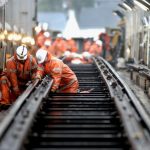 For a long time, augmented reality seemed to be a technology in need of a real problem for it to solve. There does appear however to be a growing number of applications that suggest the technology may have arrived after all.
For a long time, augmented reality seemed to be a technology in need of a real problem for it to solve. There does appear however to be a growing number of applications that suggest the technology may have arrived after all.
For instance, I’ve written about it’s use in areas as diverse as training surgeons to supporting motorists, and the range of applications is impressive. The latest example comes in the rail industry, with maintenance workers on the Greater Boston rail system using AR glasses as they maintain the tracks.
The company are using software from AMA XpertEye to connect up the glasses with a web interface so that engineers can communicate directly with experts back at base. Field engineers can stream live video back to head office whilst maintaining a live audio link.
Smart maintenance
In addition to providing live support to field engineers, the videos can also be saved, whether for use in training or for more detailed analysis at a later date.
It’s part of a growing trend towards making the maintenance of the rail network smarter. I wrote earlier this year about a German startup that is using AI to detect when tracks are in need of repair. The system places a device on the tracks to measure vibrations as trains roll over them.
Or you have the Israeli startup that is using drones to monitor utility networks for things such as high risk foliage. Whilst it sounds a rather flimsy use of time, it’s a serious problem, with utility companies spending approximately $7 billion a year inspecting their network to ensure trees don’t fall on power lines.
There’s a lot of talk of technology destroying jobs, but these are all examples of how technology can augment the work we do and make us more efficient. The smart glasses are set to be tested out in three locations in the Boston area, after which they hope to roll it out more widely, and potentially even equip drivers with the technology so that, with help of trained staff back at base, they can conduct repairs themselves.
It’s certainly an interesting idea and it’s easy to see applications in many other areas than rail maintenance. Maybe augmented reality has found its time after all.